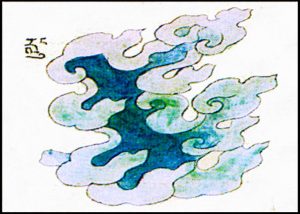
As with any medical system, understanding physiology (the organs, systems and substances of the body) is essential to Tibetan medicine. However, the underlying Three Principles of Function that create and maintain those structures and functions are of primary importance.
THEORY OF THE FIVE ELEMENTS
(Tib. Jungwa Nga; བྱུང་བ་ལྔ)

The ‘physics’ that describe qualities of the primary physical principles occurring in nature. These principles are named for their most identifiable physical manifestations: Earth, Water, Fire, Wind and Space. The characteristics, of all matter, energy and principles existing in the natural world, EG: the function of our body and mind – result from the qualities of these elements individually or in combination.

EARTH (Tib. Sa; ས) has qualities of firmness and stability and therefore provides the basis of EG: physical existence and development.


FIRE (Tib. Mae; མེ) creates things such as heat, transformation, dynamic function and activity.

WIND (Tib. rLüng; རླུང) creates motion and so enables all aspects of circulation and movement.

THE THREE PRINCIPLES OF FUNCTION OF BODY AND MIND
(Tib. Nyepa sum; ཉེས་པ་གསུམ)
As with any medical system, understanding the organs systems and substances of the body is essential in Tibetan medicine. However, the underlying three principles of function which create and maintain those functions are of primary importance. Tibetan medicine defines those Principles of Function in this manner:

1) rLüng (Pron. Loong; Tib. རླུང; aka: Wind) – Comprised of the Wind element. rLüng creates all movement and circulation in the body. That is, the movement of matter, EG: blood and digested nutrition; the circulation of true energy, EG: that which occurs in the nervous system, and the movement of those phenomena that cannot necessarily be measured such as thoughts moving in the mind. Developmentally, our capacity to express attachment, that is, a materialist world view is manifested as rLüng.

2) mKhrispa (Pron. Ṭree pa; Tib. མཁྲིས་པ ; aka: Bile) –Comprised of Fire element. Provides fundamental heat to the body. It is involved in very many physiological functions, EG: digestion esp metabolism and assimilation and liver function. Developmentally, our innate capacity to express aggression, anger, frustration or resentment, is manifested as mKhrispa.

3) Bädkën (Pron. Peh ken; Tib. བད་ཀན ; aka: Phlegm) – Comprised of the Earth and Water elements. Provides fundamental cooling for the body and is the basis for many physiological functions, EG: creating the physical principle whereby energy can be utilized to produce function, provides stability to the body and mind, provides our body’s lubrication, breaks down food at the initial stages of digestion. Developmentally, the mind expressed as ignorance or incomprehension is manifested as Bäkän.